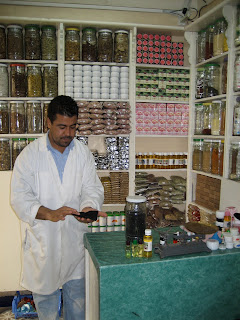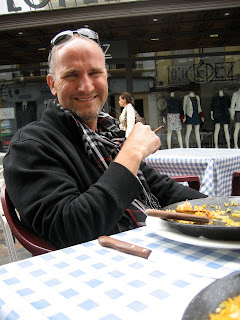







 We spent a wonderful, relaxing final day in Morocco with our guide, Abde. We had a leisurely wander through the medinas and souks of Marrakesh, including stops in a spice shop and a rug shop where we purchased a beautiful rug to bring home. I read in one of the guidebooks that you've done a good job bargaining when the seller is unhappy when you leave. If that's the case, we got a good deal because this guy barely spoke to us when we left.
We spent a wonderful, relaxing final day in Morocco with our guide, Abde. We had a leisurely wander through the medinas and souks of Marrakesh, including stops in a spice shop and a rug shop where we purchased a beautiful rug to bring home. I read in one of the guidebooks that you've done a good job bargaining when the seller is unhappy when you leave. If that's the case, we got a good deal because this guy barely spoke to us when we left.
After lunch we visited a couple more museums and the ruins of a royal palace which included a large pulpit from the oldest mosque in Marrakesh. The pulpit was commissioned in 1137 A.D. by the governor of the area, from artisans in Cordoba, Spain and delivered to Marrakesh about a year later and installed in the mosque. Several years later, the area was taken over by a rival leader who ordered the mosque destroyed, so he could build one to his own liking. But he saved the pulpit and moved it into the new mosque where it was in use until 1969, when it was removed, underwent some restoration, and placed in a museum. About half of the original inlay and carving has been damaged or removed but it is in incredible condition considering it was used for over 800 years!
Finally: a few reflections on our time here in Morocco:
Wendy:
I'm totally amazed by the influence the French have had over Moroccan culture and language, considering they only ruled here for about 45 years. Darija (Moroccan Arabic) and classic Arabic are quite different and when listening to Mouad and Abde speak, I heard many French words interspersed in their conversation.
Speaking of French, apparently Moroccans learned their driving habits from them. Only worse. Molly described crossing the street on foot as "playing Frogger". If you know that video game, you'll know exactly what she means and it's a perfect description.
One of my earlier posts included things that we found everywhere in Morocco. Here are a few things we seldom found that would have been nice to have more (or any) of:
- teaspoons/tablespoons (they have serving spoons and demitasse spoons - I felt like an idiot eating my cereal/fruit with either one)
- toilet paper - yes, more common in bigger cities but it would be nice to know you can depend on it being there when you need it :)
- chilled beverages - I mean REALLY chilled
- trash cans - I know this would mean that you would have to figure out trash collection but they could really use a Lady Bird Johnson-style anti-littering Beautify Morocco campaign.
Spending considerable time with several Moroccans, and interacting with hundreds more has broadened my horizons in such a positive way. The images we (Americans) get of Arabs in our home media is so lopsided - they are seldom depicted in a positive way. But in fact, we have spent the past week with quite possibly the friendliest group of people I have ever met: a Berber in the middle of the desert who realized we were Americans and gave us a big grin, a thumbs up, and said "Obama, yes!?"; shopkeepers who bargained with us for 2 minutes and then bid us farewell like we were old friends; Molly's Moroccan (and American) friends who went out of their way to meet us while we were here; our guide and our driver who watched out for us every minute of the day, made our visit here easy, and were proud to show off their country. Of course not all Arabs are necessarily friendly to Americans but the vast majority, and certainly Moroccans, are - you should all come visit someday.
Tim:
As the week progressed, I began to see with greater understanding how Moroccans feel not just about each other, but everyone. At first, I thought everyone knew each other. People would greet with warm handshakes and just dive into conversation. I began to realize that's typical whether it's a renewed acquaintance or they'd just met.
Another telling sign is how people treat animals here. Cats are more than tolerated, they are cared for and they are all feral. Pigeons are fed, morning doves allowed to take seeds from the grain sacks. Canaries in clean cages are all over the medinas.
This is a pretty hard culture to remain an introvert (no wonder Molly loves it here!). As Wendy mentioned, the social pleasantries are frequent and genuine. Although we couldn't understand the language, we could certainly understand the meaning. I enjoyed how Muoad and Abde would rehash an event that had just occurred (police checkpoint - usually just before an isolated stretch). The gents had to discuss it at length. Conversations here are collaborative; more parallel than serial. One would concur or dissent with a point continuously ("Ahhh..., Eye..., Zhou Zhou"). Very melodic and pleasant.
I leave Morocco with some sadness, many fond memories and new friends whose pride in their marvelous country is well founded.



















































